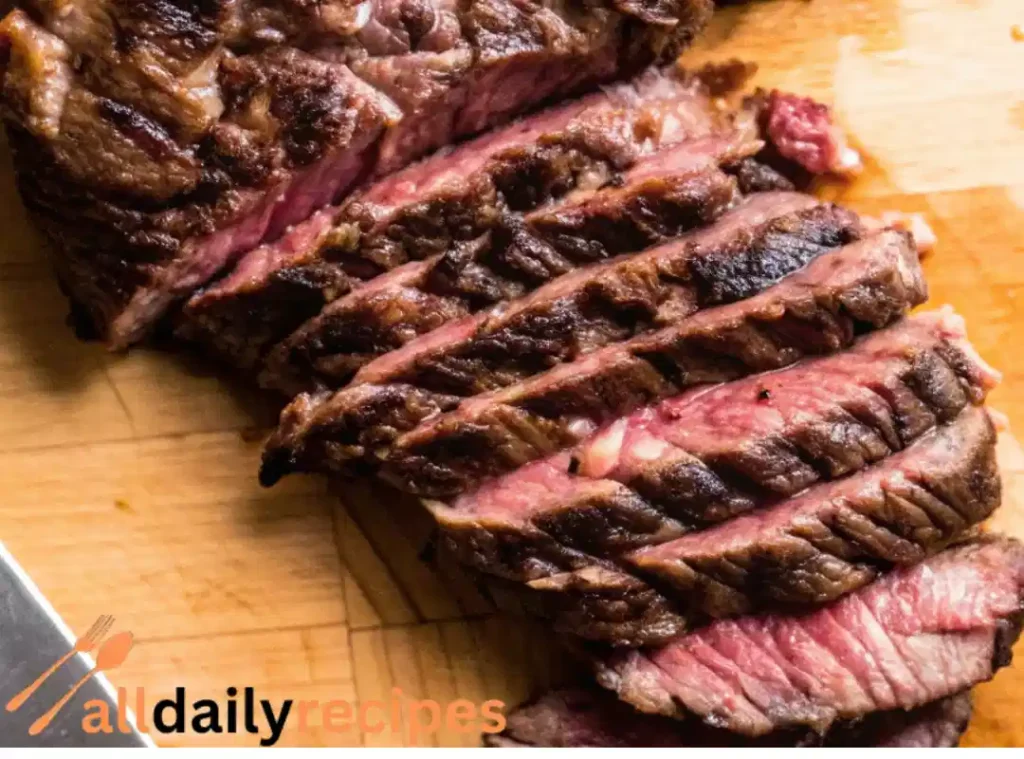Beef skirt steak has become one of my go-to cuts when I want something fast, flavorful, and affordable. The first time I cooked skirt steak, I was amazed by how juicy and tender it turned out with just a few simple ingredients and a quick sear. It became an instant favorite for weeknight dinners, summer grilling, and taco night. The best part? It cooks in minutes and delivers a rich beefy taste that rivals more expensive cuts.
In this guide, we’ll dive into everything you need to know about beef skirt steak. From how to choose and prepare it, to how to cook it perfectly, plus expert tips, serving ideas, and storage advice. Whether you’re new to cooking steak or just looking to elevate your skills, this article will help you make the most of this underrated gem. Let’s get started with this flavorful cut that deserves a spot in your kitchen.
Table of Contents
Why You’ll Love This Recipe
- Quick to cook with high heat in just minutes
- Budget-friendly compared to other steak cuts
- Bursting with bold beef flavor
- Perfect for fajitas, tacos, or steak salads
- Easy to slice and serve for any occasion
Ingredients
- 1 to 1.5 pounds beef skirt steak (inside or outside cut)
- 2 tablespoons olive oil
- 1 teaspoon garlic powder
- 1 teaspoon onion powder
- 1/2 teaspoon paprika (optional for smoky flavor)
- Salt and black pepper to taste
- Juice of 1 lime (optional for serving)

Step-by-Step Instructions
- Prep the Steak: If needed, trim excess silver skin or membrane from the steak. Pat the steak dry with paper towels to help it sear well.
- Season the Steak: In a small bowl, combine garlic powder, onion powder, paprika, salt, and pepper. Rub the spice mix onto both sides of the steak.
- Heat the Pan: Preheat a heavy skillet (cast iron is best) over high heat until very hot. Add olive oil and swirl to coat.
- Sear the Steak: Add the steak and cook without moving for 2-3 minutes per side until a brown crust forms. Flip and cook the other side. For medium-rare, aim for an internal temp of 130°F.
- Rest and Slice: Let the steak rest on a plate for 5 minutes. Slice thinly against the grain for maximum tenderness.
- Serve: Drizzle with lime juice if desired and serve hot with your favorite sides.
Pro Tips and Variations
- Tenderize with Marinade: For extra flavor, marinate in lime juice, garlic, and olive oil for 30 minutes.
- Grill Option: This steak also shines on a hot grill. Use the same seasoning and cook 2-3 minutes per side.
- Flavor Boost: Add a pinch of cumin or chili powder to the spice rub for deeper flavor.
- Substitutions: If skirt steak is unavailable, try flank steak or flap meat, using the same cooking method.
- Slicing is Key: Always slice against the grain to avoid chewiness. Look at the direction of the muscle fibers and cut perpendicular to them.
Serving Suggestions
Skirt steak is incredibly versatile.
- In warm tortillas with pico de gallo and avocado for tacos
- Over a bed of greens with corn and black beans for a hearty salad
- On top of rice with grilled vegetables for a quick bowl
- With roasted potatoes and steamed green beans for a classic steak dinner
- Sliced in sandwiches or wraps with a creamy dressing or sauce
Pair with drinks like iced tea, sparkling water, or a fruit-based mocktail. Add sides that balance the richness fresh salsa, slaw, or grilled corn work well.
How to Store Beef Skirt Steak
- Refrigerate: Store cooked steak in an airtight container for up to 4 days. Keep it whole, not sliced, to retain juices.
- Freeze: You can freeze raw or cooked skirt steak. For raw, freeze in its marinade or seasoning. For cooked, wrap tightly and use within 2 months.
- Reheat: Warm leftovers gently in a skillet over low heat or microwave in short intervals with a splash of broth to prevent drying.
Nutrition Information
(Approximate per 4 oz serving)
- Calories: 220
- Protein: 24g
- Fat: 13g
- Carbs: 1g
- Fiber: 0g
- Sugar: 0g
- Iron: 15% DV
FAQs
What’s the difference between skirt and flank steak?
Skirt steak is longer, thinner, and more flavorful. Flank is leaner but still tasty. Both cook quickly and slice best against the grain.
Can I use the oven to cook skirt steak?
Yes, broil on high for 2-3 minutes per side. Watch closely to avoid overcooking.
Do I have to marinate skirt steak?
No, but a short marinade adds flavor and helps tenderize. Even 30 minutes can make a difference.
Why is my skirt steak tough?
It may have been overcooked or sliced with the grain. Always cook quickly over high heat and slice against the grain.
Conclusion
Beef skirt steak is a delicious, fast-cooking cut that’s perfect for busy weeknights or summer grilling. It’s budget-friendly, loaded with flavor, and easy to master with a few simple techniques. Once you learn how to cook it and slice it right, you’ll want to make it a staple in your kitchen.
Try this beef skirt steak recipe and share your experience with friends or family. Whether you serve it in tacos or over rice, it’s sure to become a favorite.
Related Article:

Perfect Beef Skirt Steak
Ingredients
Equipment
Method
- Step 1: Trim off any silver skin or membrane from the steak if needed. Pat the steak dry with paper towels to promote better browning.
- Step 2: In a small bowl, mix garlic powder, onion powder, paprika, salt, and pepper. Rub the seasoning evenly over both sides of the steak.
- Step 3: Preheat a cast iron skillet over high heat until very hot. Add olive oil and swirl to coat the pan.
- Step 4: Place the steak in the pan and sear without moving for 2–3 minutes. Flip and cook the other side for another 2–3 minutes until a crust forms. For medium-rare, cook to 130°F internal temperature.
- Step 5: Transfer the steak to a plate and rest for 5 minutes to allow juices to redistribute.
- Step 6: Slice thinly against the grain for tenderness. Drizzle with lime juice if desired and serve immediately.
